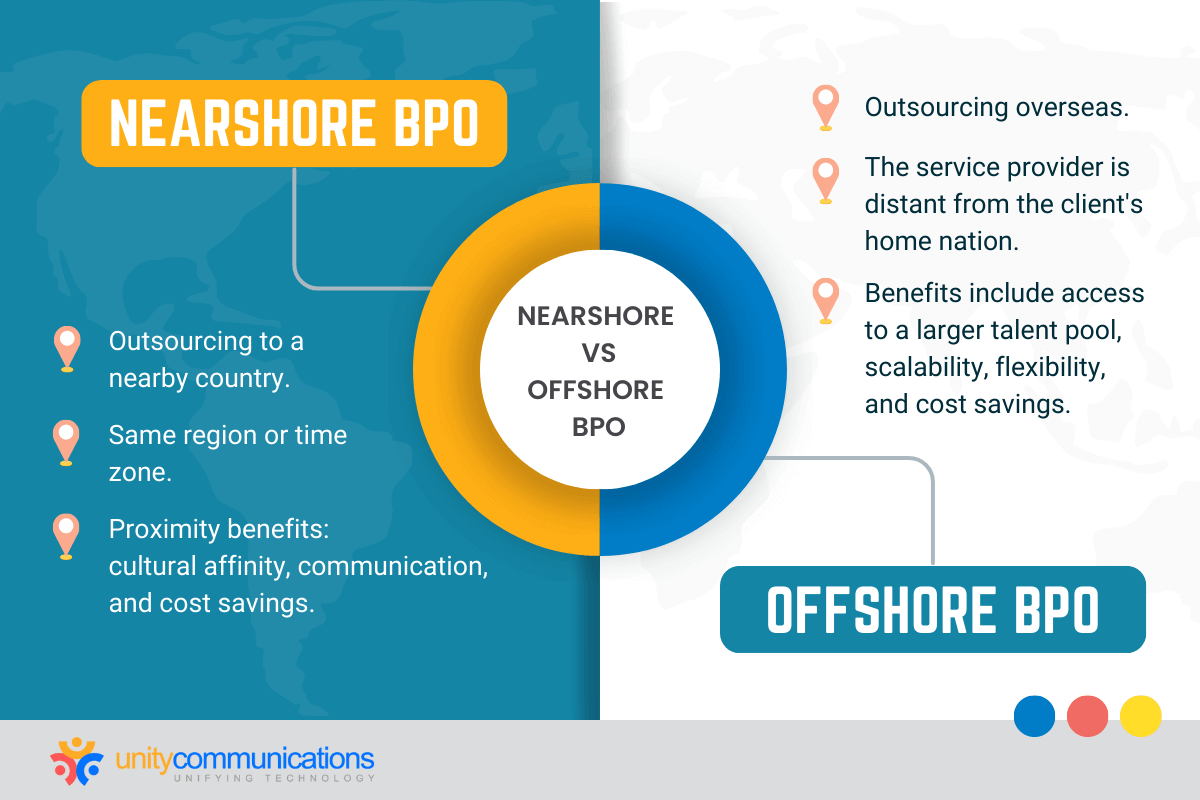Table of Contents
Business process outsourcing (BPO) lets you strike a balance between cost reduction and service quality. Companies of all sizes outsource tasks to third-party providers in different countries to leverage these benefits.
However, is there a difference between outsourcing overseas and to a nearby country? Which is a better option for your business?
This page covers nearshore vs. offshore BPO. Read on to understand their differences and determine which strategy is best for you.
Nearshore vs. Offshore BPO: Definitions

To start, what is BPO, and why do companies adopt it? BPO involves delegating processes to third-party service providers within or outside the country. It allows small and mid-sized enterprises (SMEs) and big brands to access expertise and technology. Working with offshore vendors also reduces labor costs by up to 70%, allows companies to focus on core operations, and improves business performance.
More and more businesses outsource to overseas service providers and will continue to do so in the next few years, whether through nearshore or offshore BPO. Learn about their differences in the next section.
What Is Nearshore BPO?
Nearshore BPO entails the practice of outsourcing business processes to a service provider located in a neighboring country. Typically, in this outsourcing form, the service provider and the client company are situated within the same geographical region or share a similar time zone.
Example: Consider the case of Slack’s expansion and success. Faced with a shortage of expertise and technology, the company engaged the services of MetaLab, a Canadian design team, to develop the beta version of their application. What initially commenced as a basic messaging app became a robust online business communication platform.
What Is Offshore BPO?
Offshore BPO involves outsourcing business processes to a service provider overseas. The BPO vendor is far away from the client’s home nation. The location is key to distinguishing between nearshore and offshore BPO.
Example: Let us take our case study on a telecom company as an example. Due to its growing customer base and shift to remote work, the company sought our offshoring services to optimize its back-end operations. We established a back-office team to handle admin tasks and sales functions, increasing productivity by 70% and customer satisfaction (CSAT) by 92%.
Nearshore vs. Offshore BPO: Key Differences

Now that you know the definition of nearshore vs. offshore BPO, let us dig in further. See the table below to further understand their differences.
| Key Differences | Nearshore BPO | Offshore BPO |
|---|---|---|
| Geographic Proximity | Nearby country | Distant country |
| Time Zone Difference | Similar time zone | Six to 12-hour time zone difference |
| Accessibility and Availability | Travel ease Similar business hours | Long travel 24/7 operation |
| Labor and Operating Costs | Lower cost of living Reduced expenditures | Lower cost of living High-cost savings |
| Talent, Technology, and Tools | A vast pool of skilled talent Similar digital tools and modern technologies | A diverse pool of skilled workforce Expanding infrastructure |
| Privacy, Security, and Compliance | Familiarity with the clients’ laws and regulations | Legal and regulatory compliance risks |
| Language, Culture, and Practices | English language proficiency Similar cultural norms Shared business practices | Language barriers Cultural differences Different working styles |
| Top Outsourcing Destinations | Latin America (Brazil, Mexico, etc.) Europe (Ukraine, Poland, etc.) | Asia (The Philippines, India, etc.) |
Now, let us expound on each factor.
- Geographic proximity. Nearshore BPO providers operate in countries relatively close to your home nation, often within the same or similar regions. In contrast, offshore BPO providers are in distant countries, typically in different regions.
- Time zone difference. Nearshore BPO providers share similar time zones with your location, facilitating real-time communication and collaboration. Conversely, offshore BPO providers operate in significantly different time zones, potentially posing challenges to seamless interaction.
- Accessibility and availability. Due to their geographical proximity and time zone alignment, nearshore BPO providers are more accessible. However, their agents may follow standard business hours. Offshore providers, while less accessible geographically, often offer 24/7 availability.
- Labor and operating costs. Due to the lower cost of living in the vendor’s location, both nearshore and offshore outsourcing strategies have cost-saving advantages. Offshore outsourcing, in particular, offers substantial cost reductions.
- Talent, technology, and tools. Nearshore and offshore countries boast expansive and diverse talent pools. Countries near your home nation often share similar technology and resource availability. In contrast, leading offshore destinations like the Philippines and India actively invest in infrastructure expansion.
- Privacy, security, and compliance. Both nearshore and offshore BPO providers carry certain risks related to privacy and security. Additionally, they may lack familiarity with the specific laws and regulations pertinent to your business, potentially impacting compliance. Offshore providers tend to have a higher associated risk in this regard.
- Language, culture, and practices. Nearshore companies may share language, cultural norms, and business practices that align closely with their clients. In contrast, working with offshore providers may require dedicated efforts and resources to address language and cultural barriers.
- Top outsourcing destinations. Notable nearshore BPO destinations include Latin American countries like Mexico and Brazil and emerging European BPO players such as Ukraine and Poland. Leading offshore outsourcing destinations in Asia encompass India, the Philippines, and Malaysia.
Nearshore vs. Offshore BPO: Pros and Cons

The BPO industry will continue to expand in the next few years. According to Research and Markets, the global BPO market could grow to $477.7 billion by 2030 at a compound annual growth rate (CAGR) of 6.3%.
Such market growth proves the potential benefits of outsourcing, whether nearshore or offshore. However, businesses looking to outsource should prepare for possible challenges and risks. They should weigh the pros and cons before entering into an outsourcing engagement.
Advantages of Outsourcing
Let us look at the advantages of nearshore and offshore BPO.
- Cost reduction. Businesses of all sizes outsource to nearshore providers to cut labor costs and operating expenses. They go as far as outsourcing to offshore providers due to the significant cost savings they offer in the long term.
- Accessible T’s. SMEs and big companies hire service providers to access talent, technology, and tools. Whether nearshore or offshore, the top outsourcing nations have a diverse pool of highly skilled talent. BPO firms invest in digital tools and technologies, expanding infrastructure, and other resources.
- Improved services. Businesses benefit from foreign providers’ high-quality services. They create service-level agreements (SLAs) that onshore or offshore BPO firms strictly follow. They also set key performance indicators (KPIs) focusing on efficiency, quality, and CSAT for providers to meet.
- Business profitability. Aside from decreasing costs, nearshore and offshore BPO can also increase profits. SMEs and big companies access expertise and technology that can streamline their operations, improve their services, and boost their revenue.
- Growth and expansion. Businesses looking to grow and expand heavily rely on nearshore and offshore BPO. Both options allow them to establish operations in other countries and penetrate new markets. They are ideal for achieving global expansion in this time and age.
- Other perks and benefits. Aside from those mentioned above, businesses can capitalize on other countries’ tax incentives, favorable laws, government support, and digital business environment. These factors help scale their operations and grow their businesses.
Disadvantages of Outsourcing
Let us look at the disadvantages of nearshore and offshore BPO.
- Lost control over business. Outsourcing business processes means handing over responsibilities to an external party. Such a move can be riskier when delegating tasks to foreign providers, which might result in losing control. To avoid this, ensure regular communication and collaboration with your hired provider.
- Goal misalignment. You might encounter a misalignment in operational objectives, especially when you work with foreign providers. So, set a comprehensive SLA with clear KPIs so your provider knows what you aim to achieve from BPO.
- Privacy and security risks Hiring nearshore or offshore providers means exposing your business and customer data to physical and cyber attackers. Hire a reputable BPO firm with reliable data privacy policies and network security protocols to safeguard your information.
- Communication issues. Working with foreign providers can lead to communication problems due to time zone differences and language barriers. This can result in potential conflicts and work delays. Choose a BPO destination with high English proficiency and robust communication protocols to avoid negatively impacting your operation.
- Cultural gaps. The service provider might have different cultural norms, working styles, and business practices. When working with foreign providers, understand their culture and know how to approach them. Offer proper cultural orientation and training to reduce misunderstandings.
- Potential disruptions. Outsourcing to overseas providers can increase the risk of potential disruptions, such as natural disasters or political instability. They can lead to possible delays, downtime, and other issues. When working with a nearshore or offshore provider, set contingency plans.
The Bottom Line
Understanding the differences between nearshore and offshore BPO is crucial to making informed decisions. Nearshore BPO entails working with a service provider in a nearby country, while offshore BPO involves outsourcing to a faraway overseas country.
Choosing between a nearshore and offshore outsourcing company depends only on your business needs. Both BPO options have pros and cons that you can manage as long as you know your business needs and outsourcing requirements. So whether nearshore or offshore BPO, the right service provider will help your business thrive and flourish.
Let’s connect if you are looking to hire an offshore provider in the Philippines. Since 2009, Unity Communications has been working with businesses in the U.S. and other countries. We have a proven BPO track record of scaling business operations and reducing expenditures.



